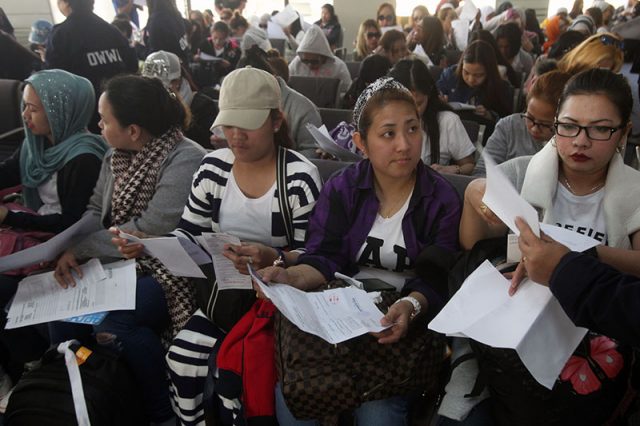
An aspiring photographer posted a series of photos on social media which he hopes would show the sacrifices of overseas Filipino workers for their families at home.
Antonio Vazquez, who graduated from the Institute of Creative Entrepreneurship-Fashion Arts Design or ICE-FAD, shared that the shoot was for a gallery called “Ang Bagong Barangay.”
"OFW"A shoot for the @barangaybois gallery "ang bagong barangay"💃 @graydelf💄 @celinecabildo👚 @giauhn.Shot in…
Posted by Antonio Vazquez on Monday, January 28, 2019
“It tackles more on the difficult side of being an OFW, yet still manage to fight for the future of their loved ones,” Vazquez said in the caption.
OFW
A series of photos that showcase the struggles of being an ofw, yet still fight for their loved ones.
Shot this in film. pic.twitter.com/WdEHEufRJL— Antonio Vazquez (@antonioTvazquez) January 29, 2019
His photos got mixed reactions from different sectors.
Gideon Peña thinks that each photo represents the situation of OFWs.
I surmise the aesthetic itself is also a metaphor. Some people think that working overseas is glamorous, but behind the perceived “beauty” are the unseen struggles, melancholy, pain.
That’s just my interpretation. I don’t personally know the one who shot them.
— Gideon Peña (@gideonpena) January 30, 2019
Others perceived that the photos do not really reflect the real plight of Filipino workers abroad.
I'm not sure if I just don't get it, but something here doesn't feel right. https://t.co/qlOVoXtHeD
— Nathania (@PilosopoTanya) January 30, 2019
Reality of OFWs
Filipino workers abroad are regarded as modern-day heroes for the risks they take just to provide for their families at home.
According to the Philippine Statistics Office survey in 2017, there are more than two million OFWs and 53.7 percent of these are female workers while 46.3 percent are male.
Fifty-nine percent of Filipino workers abroad are engaged in manual labor occupations such as domestic helpers and office cleaners.
Middle Eastern countries Saudi Arabia and Kuwait remain the top OFW destinations in the world with 57 percent.
Behind these figures, however, are the mostly unseen struggles and hazards they face such as abuse from employers, unfair treatment, sexual assault and even death.
In 2017, Jennifer Dalquez was acquitted of murder charges after being detained for three years at the United Arab Emirates.
Dalquez said in an interview that her employer attempted to rape her at gunpoint and had to defend herself.
Yes In 2016, the death of 29-year-old female domestic worker named Joanna Demafelis made headlines when her body was found in a freezer in an apartment in Kuwait.
In 2015, Mary Jane Veloso, who got apprehended for carrying 2.6 kilograms of heroin in her suitcase, escaped execution by firing squad in Indonesia when the government granted her reprieve following the surrender of her illegal recruiter.
Two high-profile cases of abuses against female OFW have also been made into controversial films.
In 1994, Sarah Balabagan’s story of being sentenced to death in the Middle East for killing her employer was among the first reported cases of domestic violence among Filipino overseas workers.
Then 14-year-old Balabagan said it was in self-defense after her employer attempted to rape her. She was released after a Filipino businessman paid blood money to the employer’s kin.
Her sentence was reduced to one-year imprisonment, 100 lashes of a cane and payment of P2 million.
In 1995, the execution by hanging of Flor Contemplacion strained the relations of the Philippines and Singapore. Contemplacion was accused of killing another Filipino woman and her son.
She initially confessed, but witnesses claimed that she did it under duress. She was reportedly tortured and raped by Singaporean interrogation officers to force a confession from her.
Former President Fidel Ramos appealed to stop the execution but the government of Singapore proceeded.









